Review: Anker PowerCore 5000
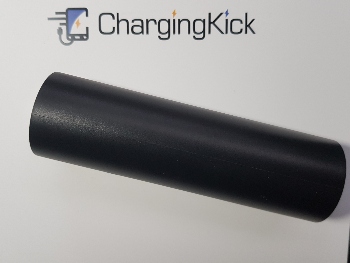
Small power banks that enable you to charge a phone once are handy devices to have in your backpack or purse. The Anker PowerCore 5000, which has more than 22,000 reviews on Amazon, is the most popular small power bank on the market. But is it as good as the reviews say? Read on to find out.
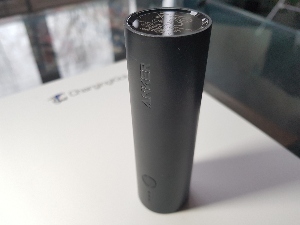
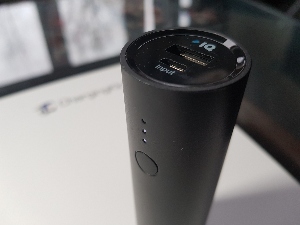
Pros & Cons:
Pros:
Unique shape
Robust construction
Portable and handy
Good recharging speed
Cons:
Doesn’t provide fast charging
Below-average charging speed
Rating
Power & Performance (1 to 5 stars)
Design & Build (1 to 5 stars)
Technology (1 to 5 stars)
Overall Rating (average of above)
Key Specifications of a Product
Key Specs:
Capacity
5,000 mAh / 18.5 Wh
Dimensions (LxWxH)
4.3 x 1.3 x 1.3 in / 10.8 x 3.3 x 3.3 cm
Weight
4.7 oz / 134 gm
Output & Input Charging:
Average Charging Time of a Mobile Phone (average battery capacity 3000mAh)
1 hour and 40 minutes
Average Recharging Time (from 0% to 100%)
2 hours and 45 minutes
Ports
Micro USB Input: 5V/2A
USB-A Output: 5V/2A
Charging Technology
PowerIQ
VoltageBoost
Flight Status
Under 100WH
Safe to take on board.
Other Features
18-Month Limited Warranty
Lifetime Technical Support
Ideal For?
Travelers
Minimalists
Students
Businesspeople
What Inside?
Anker PowerCore 5000
Protective pouch
Micro USB cable
Manual in multiple languages
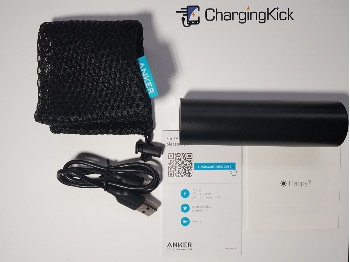
Power & Performance
Battery Capacity
Battery capacity in mAh and Watts
The Anker PowerCore 5000 is a small power bank with a battery capacity of 5,000 mAh / 18.5 Wh. This should be enough to charge most mobile phones at least once.
Capacity test: discharge the fully charged power bank
Have you ever wondered whether a power bank has its battery capacity? Does it really have 5,000 mAh or 10,000 mAh, as advertised? What is the real battery capacity?
To check the actual battery capacity we need:
The fully charged power bank
A USB tester that shows the current, voltage, mAh, and charging time.
The USB mini adjustable load receives energy from the power bank and releases it safely via the fan. This is the safe way to discharge a fully charged power bank and measure the real battery capacity.
I connect the dummy load (amperes are set to 2) to the USB tester, then plug it into the fully charged power bank. Once that’s done, I wait until the power bank’s battery goes flat. The screen on the USB tester will display the Watt-hours and the amount of mAh consumed. These data show the real battery capacity.
Using the aforementioned procedure, I tested The Anker PowerCore 5000. Here are the results:
Capacity Test

Results
Discharge Time - 1 hour and 27 minutes
Watt-Hours - 14.3 Wh
Ampere hour - 2,868 mAh
The real battery capacity is 2,868 mAh / 14.3 Wh. This mAh measurement shows you the energy you will fully use to charge your mobile phone. It’s not 5,000 mAh, because the unit is converting energy from 3.7V (the power bank’s battery voltage) to 5V (USB voltage). This loss occurs in every power bank.
When you know the advertised and real battery capacity, it’s possible to measure the battery efficiency, which in this case is 78%. Manufacturers frequently don’t share this information. Efficiency above 90% is considered very good. The PowerCore 5000 with its battery efficiency at 78% is an average score. Especially in a small battery, poor efficiency is more noticeable.
Disclaimer: Every test can produce different results, but only small variations.
How many times can you charge the most popular mobile phones in 2020?
To put the battery capacity into perspective, I will use a formula for Real Battery Capacity and calculate how many times the Anker PowerCore 5000 can charge the top 10 most popular mobile phones in 2020. Perhaps you own one of them, or at least you know your mobile phone’s battery capacity.
From the previous test, we know the real battery capacity is 2,868 mAh.
Once we know the real battery capacity, we simply divide it by the enlisted mobile phones’ battery capacity to find out how many times it can be charged.
Mobile Phone Model | How Many Times Can It Be Charged? |
4.61 | |
3.05 | |
2.88 | |
2.88 | |
3.24 | |
7.13 | |
2.88 | |
4.13 | |
3.09 | |
2.60 |
Only iPhones phones from this list will be definitely fully charged. Potentially Google Pixel 4a will be charged fully. But the rest of enlisted phones, it’s quite unlikely. Modern mobile phones have batteries over 4,000 mAh, hence small power banks can’t provide substantial amounts of energy. It’s important to know it before purchasing.
Output Charging
Charging Time & Power Usage
Power banks are used mainly to charge devices. Therefore, this review would not be complete without testing output charging. For this, knowledge of the device’s charging time is crucial. Frequently it is one of the most important factors in the purchase of a power bank.
For these tests, I used two mobile phones:
Huawei P10 with a battery of 3200 mAh (Huawei SuperCharge)
Samsung S8 with a battery of 3000mAh (Adaptive Fast Charging)
Both phones support fast-charging technology.
To record data (current, voltage, mAh, time) I used a USB tester.
Real-life examples of test-charged phones demonstrate what you can expect after purchasing a power bank.
The Anker PowerCore 5000 has one USB-A port rated at 5V/2A. It’s equipped with two charging technologies: PowerIQ and VoltageBoost. The manufacturer claims that it supports fast charging, but 5V/2A can no longer be considered fast charging. When I connected the device to a Huawei P10 and Samsung S8, neither detected fast charging, but the unit should still charge the mobile phones I tested in maximum 90 minutes. Let’s check out the results.
Charging via USB-A (Huawei)
.jpg?alt=media&token=c06bb5b0-952b-4bed-ae75-ac55f8e50bc3)
It took 1 hour and 49 minutes to get a full charge. The power bank delivered 2,239 mAh / 11.8 Wh. One LED light was still flashing. This was at least 20 minutes longer than I expected.
Charging via USB-A (Samsung)
%20-%20Finish.jpg?alt=media&token=f38d4ab8-4eb9-4bc4-98b7-8d31cfbbd10c)
It took 1 hour and 28 minutes to charge the Samsung S8, roughly the time I expected. The power bank was delivering energy at 5V/1.8A for most of the time. In total, the mobile phone received nearly 2,100 mAh / 10.6 Wh.
A roundup of output charging
Most power banks with an output charging rate of 5V/2A should charge phones with a battery of 3,000 mAh within an hour and a half. The Anker PowerCore 5000 didn’t meet this charging time.
Input Charging
The Anker PowerCore 5000 has one micro USB port rated at 5V/2A to recharge the power bank. It’s a standard recharging time. With this battery capacity, the power bank should be recharged in maximum 3 hours.
For this reason, I charged the power bank twice. The first test, via a standard charger rated at 5V/2A charging speed; a charger most of us have. For the second charge, I used the charger rated 65W, the fastest type of charger, able to charge compatible laptops.
Recharging via Standard Charger
It took 2 hours and 45 minutes to charge the Anker PowerCore 5000. The energy flow was constant at the rate of 5V/2A. The power bank received a total of 4,340 mAh / 21.5 Wh.
Recharging via Fast Charger
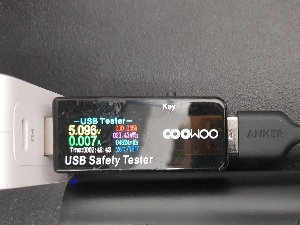
This time, it took 2 hours and 48 minutes to recharge the power bank. The power bank was receiving the energy at the rate of 5V/2A. The charger delivered a total of 4,524 mAh / 23.4 Wh.
A roundup of output charging
The output charging was disappointing since it took 1 hour and 50 minutes to charge the Huawei P10. Since it’s a small device that can slide into a pocket with a phone, it should have charged the phone more quickly. The recharging time meets the standard.
Score
Design & Build
Dimension & Weight
Weight in ounces and grams
4.7 oz / 134 g
Measurement in inches and centimeters
4.3 x 1.3 x 1.3 in / 10.8 x 3.3 x 3.3 cm
The Anker PowerCore 5000 is a handy device, which is what you expect from a small power bank. What makes this device unique is its shape. It’s a tube, not flat and rectangular as most power banks are. At only 4 inches long, 1.3 inches wide, and only 4.7 ounces in weight, it’s small enough to slide into your pocket while it charges your mobile phone.
Design & Material
As I mentioned, the Anker PowerCore 5000 has an unusual tube shape. Some might find this inconvenient; still, keeping it in your travel pouch might be useful in some situations. The rest exhibits what Anker is famous for sleek and minimalistic design.
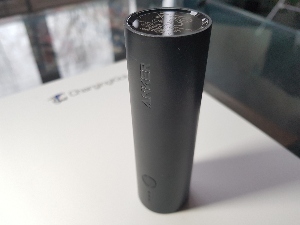
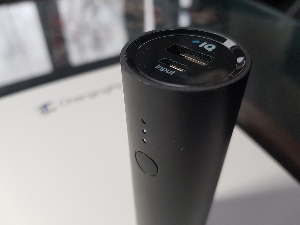
The Anker PowerCore 5000 is available in three colors: black, red and blue. All of them look great. I had the pleasure of testing the black version.
It’s made of high-quality plastic. There are no loose parts and nothing sticks out, which makes it easy to slide into my pocket while charging my mobile phone. It’s smooth to the touch and stays firmly in my hand without me leaving fingerprints.
On the side of the power bank are 3 LED lights that gently light up when you’re using or charging this product. The power button is right below the LED lights. On top of the power bank are the USB ports: a Micro-USB for recharging the power bank and a USB-A to charge your mobile phone. The layout is perfect, plugging in from the top, so once you slide it into your pocket nothing sticks out. On the bottom, we can find some product info.
It should be robust enough for daily usage under normal circumstances. However, a drop from excessive height or accidental splashes of water might damage the product.
Score
Technology
Ports
Two USB ports, USB-A for output charging and Micro USB for input charging.
UBS-A Output: 5V/2A
Micro USB Input: 5V/2A
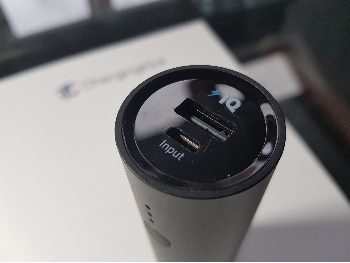
Tech
The Anker PowerCore 5000 is equipped with PowerIQ and VoltageBoost technology. PowerIQ automatically calculates the fastest charging speed for the connected device. VoltageBoost compensates for cable resistance by smoothing voltage output. Both are Anker technologies. Having said that, the tested phones didn’t detect fast charging and charged at the standard 5V/2A rate.
Score
Conclusion
Overall Opinion
The Anker PowerCore 5000 is a solid power bank, one of the best in its category. Unique shape, high-quality battery, sleek design and flawless performance make this product worth the price. Nevertheless, Anker should work on a few improvements, primarily faster charging and recharging. If you’re looking for a small power bank that easily will charge your mobile phone while it’s in your pocket, the Anker PowerCore 5000 will do the trick.